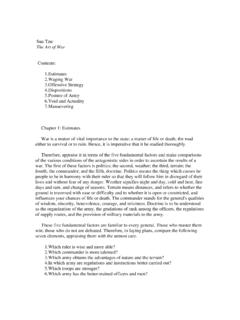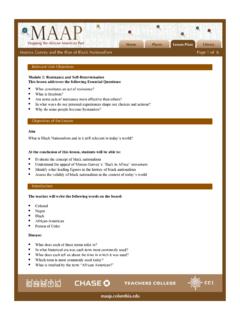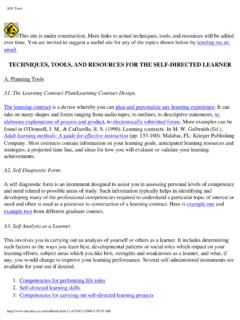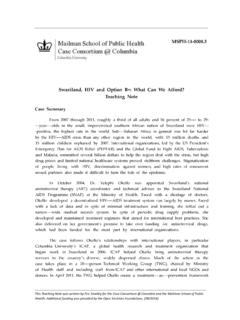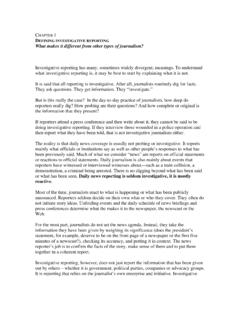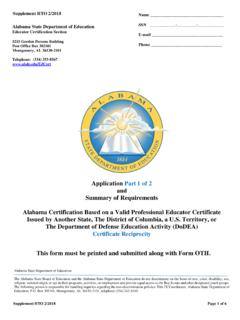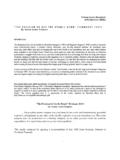Transcription of Self-Directed Learning - Columbia University
1 Self-Directed Learning Hiemstra, R. (1994). Self-Directed Learning . In T. Husen & T. N. Postlethwaite (Eds.), The International Encyclopedia of Education (second edition), Oxford: Pergamon Press. Reprinted here by permission. Most adults spend a considerable time acquiring information and Learning new skills. The rapidity of change, the continuous creation of new knowledge, and an ever-widening access to information make such acquisitions necessary. Much of this Learning takes place at the learner's initiative, even if available through formal settings. A common label given to such activity is Self-Directed Learning . In essence, self - directed Learning is seen as any study form in which individuals have primary responsibility for planning, implementing, and even evaluating the effort. Most people, when asked, will proclaim a preference for assuming such responsibility whenever possible. Research, scholarship, and interest in Self-Directed Learning has literally exploded around the world in recent years.
2 Few topics, if any, have received more attention by adult educators than Self-Directed Learning . Related books, articles, monographs, conferences, and symposia abound. In addition, numerous new programs, practices, and resources for facilitating Self-Directed Learning have been created. These include such features as Learning contracts, self -help books, support groups, open- University programs, electronic networking, and computer-assisted Learning . This article extracts some meaning from all this information. 1. What is Self-Directed Learning ? Several things are known about Self-Directed Learning : (a) individual learners can become empowered to take increasingly more responsibility for various decisions associated with the Learning endeavor; (b). self -direction is best viewed as a continuum or characteristic that exists to some degree in every person and Learning situation; (c) self -direction does not necessarily mean all Learning will take place in isolation from others; (d) Self-Directed learners appear able to transfer Learning , in terms of both knowledge and study skill, from one situation to another; (e) Self-Directed study can involve various activities and resources, such as self -guided reading, participation in study groups, internships, electronic dialogues, and reflective writing activities; (f) effective roles for teachers in Self-Directed Learning are possible, such as dialogue with learners, securing resources, evaluating outcomes, and promoting critical thinking.
3 (g) some educational institutions are finding ways to support Self-Directed study through open- Learning programs, individualized study options, non-traditional course offerings, and other innovative programs. This latter component, educational institutions developing innovative responses to Self-Directed Learning preferences, has spawned several unique programming efforts. For example, establishment of the Open University in England in 1969 generated similar efforts around the world. St. Francis Xavier University (Antigonish, Nova Scotia), Teacher College ( Columbia University , New York City), Syracuse University 's Adult Education Program (Syracuse, New York), and the Ontario Institute for Studies in (1 of 11)5/31/2006 8:23:11 AM. Education (Toronto, Canada) have incorporated Self-Directed Learning principles into various of their adult education efforts. These latter two (Syracuse University and Ontario Institute) have assimilated some computer-mediated instruction into their programs.
4 Brookfield (1986), a British adult educator now residing in the United States, describes other higher education efforts where individualized, Self-Directed Learning opportunities exist, including locations in Germany, Denmark, and Eastern Europe. Brockett and Hiemstra (1991) describe several Self-Directed efforts in China, Indonesia, Japan, Norway, Russia, Saudi Arabia, Sweden, and Tanzania. Knowles and Associates (1984) describe various Self-Directed Learning efforts in various government, industry, health, religion, and military settings. History of Self-Directed Learning Self-Directed Learning has existed even from classical antiquity. For example, self -study played an important part in the lives of such Greek philosophers as Socrates, Plato, and Aristotle. Other historical examples of Self-Directed learners included Alexander the Great, Caesar, Erasmus, and Descartes. Social conditions in Colonial America and a corresponding lack of formal educational institutions necessitated that many people learn on their own.
5 Early scholarly efforts to understand Self-Directed Learning took place some 150 years ago in the United States. Craik (1840) documented and celebrated the self -education efforts of several people. About this same time in Great Britain, Smiles (1859) published a book entitled self -Help, that applauded the value of personal development. However, it is during the last three decades that Self-Directed Learning has become a major research area. Groundwork was laid through the observations of Houle (1961) ( University of Chicago, Illinois). He interviewed 22 adult learners and classified them into three categories based on reasons for participation in Learning : (a) goal-oriented, who participate mainly to achieve some end goal; (b) activity-oriented, who participate for social or fellowship reasons; (c) Learning -oriented, who perceive of Learning as an end in itself. It is this latter group that resembles the Self-Directed learner identified in subsequent research.
6 The first attempt to better understand Learning -oriented individuals was made by Tough, A Canadian researcher and one of Houle's doctoral students. His dissertation effort to analyze Self-Directed teaching activities and subsequent research with additional subjects resulted in a book, The Adult's Learning Projects (1979). This work has stimulated many similar studies with various populations in various locations. In parallel scholarship during this same time period, Knowles popularized in North America the term, andragogy, with corresponding adult instructional processes. His 1975 publication, Self-Directed Learning , provided foundational definitions and assumptions that guided much subsequent research: (a). Self-Directed Learning assumes that humans grow in capacity and need to be self -directing; (b) learners'. (2 of 11)5/31/2006 8:23:11 AM. experiences are rich resources for Learning ; (c) individuals learn what is required to perform their evolving life tasks; (d) an adult's natural orientation is task or problem-centered Learning ; (e) self - directed learners are motivated by various internal incentives, such as need for self -esteem, curiosity, desire to achieve, and satisfaction of accomplishment.
7 Another important research effort was Guglielmino's (1977) dissertation. She developed the self - directed Learning Readiness Scale (SDLRS), an instrument subsequently used by many researchers to measure Self-Directed readiness or to compare various Self-Directed Learning aspects with numerous characteristics. Spear and Mocker's (1984) work on organizing circumstances showed how important it is to understand a learner's environmental circumstances in promoting Self-Directed Learning . Establishment of an annual International Symposium on Self-Directed Learning in 1987 by Long and his colleagues completes this historical picture. The Symposia have spawned many publications, research projects, and theory building efforts by researchers throughout the world. Competing Concepts As with the development of many new ideas, Self-Directed Learning has created some confusion in that many related concepts are often used interchangeably or in similar ways.
8 Examples include Self-Directed Learning , self -planned Learning , Learning projects, self -education, self -teaching, autonomous Learning , autodidaxy, independent study, and open Learning . Yet these terms typically offer varied, though sometimes subtly different, emphases. To illustrate some of these differences, six competing terms will be examined. Section provides a conceptual model and corresponding definition of Self-Directed Learning . (a) self -planned Learning and Learning projects - Tough's (1979) research on people engaged in Learning projects involved obtaining information on "a series of related episodes, adding up to at least seven hours" where "more than half of the person's total motivation is to gain and retain certain fairly clear knowledge and skill, or to produce some other lasting change" (p. 7). Tough used the seven-hour parameter because he felt it approximated a typical working day and separated brief Learning activities from more major endeavors.
9 Actually, he and many others have found that most Learning projects far exceed the seven-hour minimum. Nearly 100 Learning project surveys with various groups in ten countries have confirmed that approximately 90 percent of adults conduct at least one intentional Learning project annually. A typical adult spends about 500 hours a year in such Learning with approximately 70 percent planned by the learner. This self -planning predominance spawned considerable research on Self-Directed Learning . (b) Autonomous Learning - autonomy often is associated with independence of thought, individualized decision-making, and critical intelligence. Gibbs (1979) notes this concept "is probably the most familiar, for it is part of an individualistic, anti-authoritarian ideology .. deep-rooted in Western capitalistic democracies" (p. 121). Chene (1983), another Canadian researcher, suggests autonomy stands for psychological and methodological Learning dimensions.
10 Boud (1988) provides several ideas (3 of 11)5/31/2006 8:23:11 AM. on developing student autonomy. Candy (1991), an Australian adult educator, suggests that continuous Learning is a process in which adults manifest personality attributes of personal autonomy in self - managing Learning efforts. He also profiles various autonomous learner characteristics (pp. 459-66). (c) Autodidaxy - Candy (1991) urges that self -direction be differentiated as a goal for learner control of decision-making from an educational method in which teachers use processes for promoting self - direction. He proposes autodidaxy as a term for referring to self -instruction which takes place outside of formal institutional settings. (d) self -education - Self-Directed Learning can be called something else from country to country or culture to culture. For example, in Russia it is known as self -education: The role of self -education naturally increases in adults, for the potential possibilities of the personality are extremely great, and the formed world outlook.
